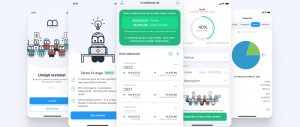Each company’s communication with possible customers starts with social media networks and corporate blogs. The development of a blog is the same important thing, as the creation of the site or landing page. Though there is a variety of platforms for quick deployment with ready-made functional decisions, the personally developed blog gives more regard to its administrator.
Blog or not to blog
Blogs give the possibility to share the information and give commentaries on the problem, described in an article. Their popularity can be explained by the absence of communicational limitations and compulsive correlations.
It is possible to define several types of blogs according to their authorship: personal, collective, and corporate. They all have their specific features and target audience, but in general, the development steps are similar.
Blog creation in several steps
It is necessary to perform the following steps to create a blog:
1.Choose the right domain and hosting
The domain code can be national (.de for Germany, .uk for the United Kingdom, or .us for the USA) or international (.net, .com, and others). It is rather important to choose the domain in the area of your target readers.
The hosting is the base that can define the carrying capacity and the amount of information on the future blog. If it is the first try in the blogging sphere, it is admissible to create a blog on free hosting. Such deployment will be fast and require small pains. Though you will have to obey the rules of hosting providers and no one can guarantee the absence of unexpected termination of services.
Paid hosts bring ready-made solutions for blog improvement and can carry unlimited traffic. Rules obedience and service termination possibility stay in the frame. Even if the host will take responsibilities for such termination, the readers can be lost anyway.
Self-hosting can be a solution for those, who can administer personal or leased servers. It gives total freedom in blog thematics choosing and moderation.
2. Choose the framework/platform
The application of particular frameworks is defined by the way the blog will be operated. Its architecture differs from other sites in the way the information is structured within it. The common blog is a multi-page site with a great number of internal links. It has search filters, categories arrangement, user types, and access levels.
The blog can be created by using various frameworks depending on its purpose. The most popular platforms for blog development are WordPress, Laravel, PHP, Python, Ruby on Rails.
WordPress is commonly used by creators due to its simplicity and possibility to add personal adjustments and customization. Everything that is needed for deployment – add files to the server, insert MySQL base data, and run the installation. This framework requires a lot of plugins that can influence server processing and increase the response rate. Though, big hosting centers and updated servers can deal with such load. The other problem can appear with customization – it requires code knowledge. WordPress has a huge library of custom design solutions that can be used instead of the implementation of coded customization.
Laravel requires more time and funds for deployment. All initial functions are to be adjusted through code application. Pagination, which makes the process of pages creation easier, is included in the framework.
3. Content creation and posting
The blog can not serve its purpose without any content. Its quality influences the possibility to stay ranked by search engines. Proper links building, semantic core creation, and placing the content over the form can improve the position. The creation of good and optimized content should take a lot of time but the results of such pains will appear at the least in 3-5 months. The biggest mistake of this period – is to cast all work and leave the blog. Scheduled hard work and patience are the keys to success.
Time, necessary for the creation
The development of the blog can take up to 2 weeks if to use the WordPress framework. One day – for deployment and adjustment of servers, one week – for customization issues, several days – final adjustment. This period can be decreased to one week or even less if to use a non-personal design that is provided by the framework. Other frameworks will require more time that will lead to a corresponding funding increase.
The time necessary for further content creation depends on each particular case. Sometimes the creation of several texts requires weeks of preparations. Moreover, if the blog contains a lot of graphical elements, video, and white papers. Anyway, the time spent on the content quality will surely bring fruits in the future.
Create a show window, not a stage
The ability to add new publications to a blog with ease defines its basic functions for users – find, structure, and sort information. The oversaturation of unnecessary information makes people miss even meaningful publications. The blog should become not a personal page of fame, but bring the information, useful for target users. In such a case they will willingly come to gain something new.
Show users that you really understand the thing you are working with and earn confidence. Even in such a situation, it is impossible to say that the blog is “done”. The creation of a blog – is a permanent thing that lasts up to the last word or picture, added to the page. When the process stops, a blog dies.
Ready to develop your own blog? Contact us and we assist you with this task.
ai application architecture banking chatbot cloud company database design Development discovery ecommerce edtech fintech fitness funding gamification healthcare idea management metrics mobile mvp pitch pitch deck product quality real estate SaaS security startup strategy technology trends web
Also you may interested in
Hello we are EVNE Developers
We're a team of product experts who can transform your vision into a thriving business
Contact us





















